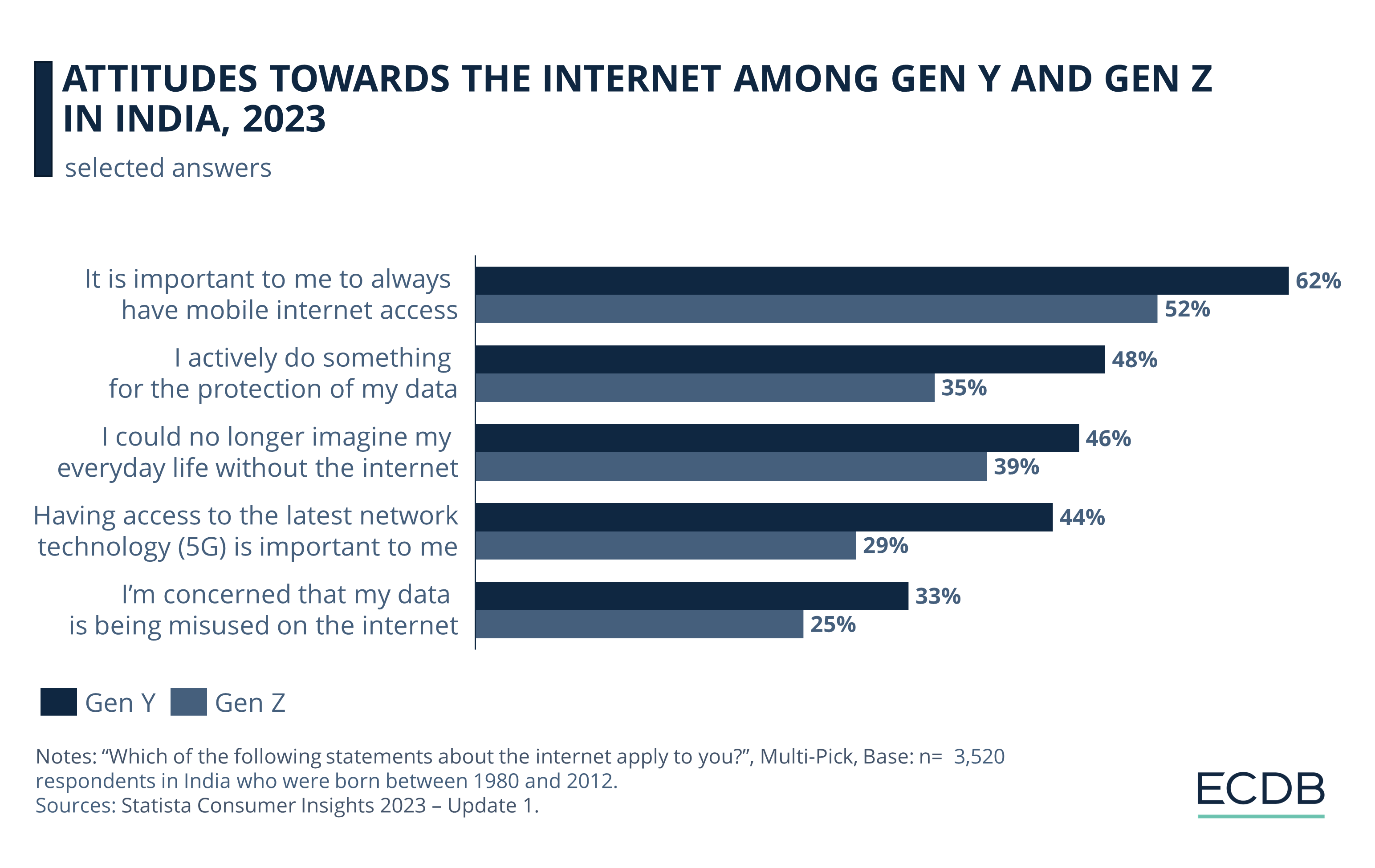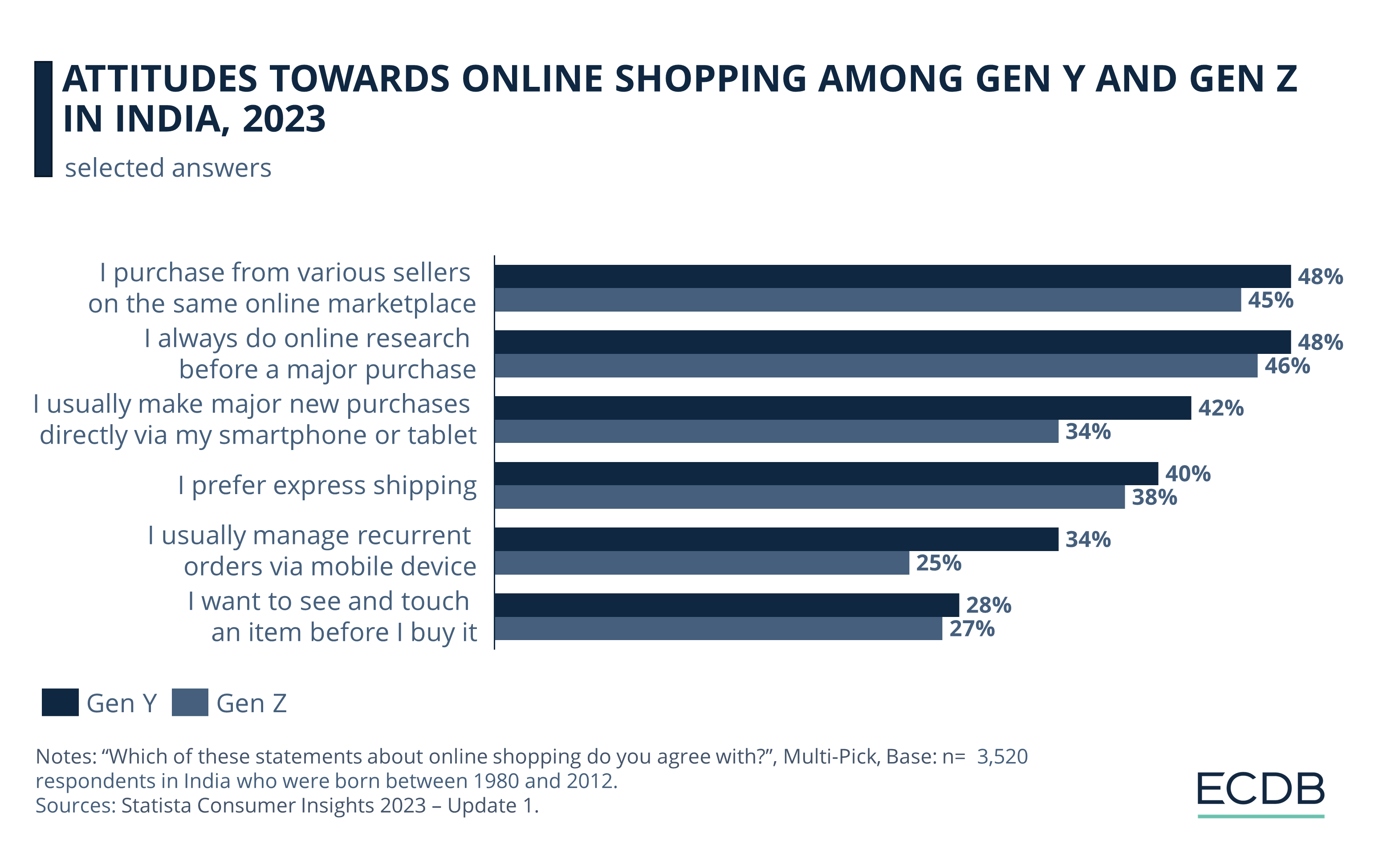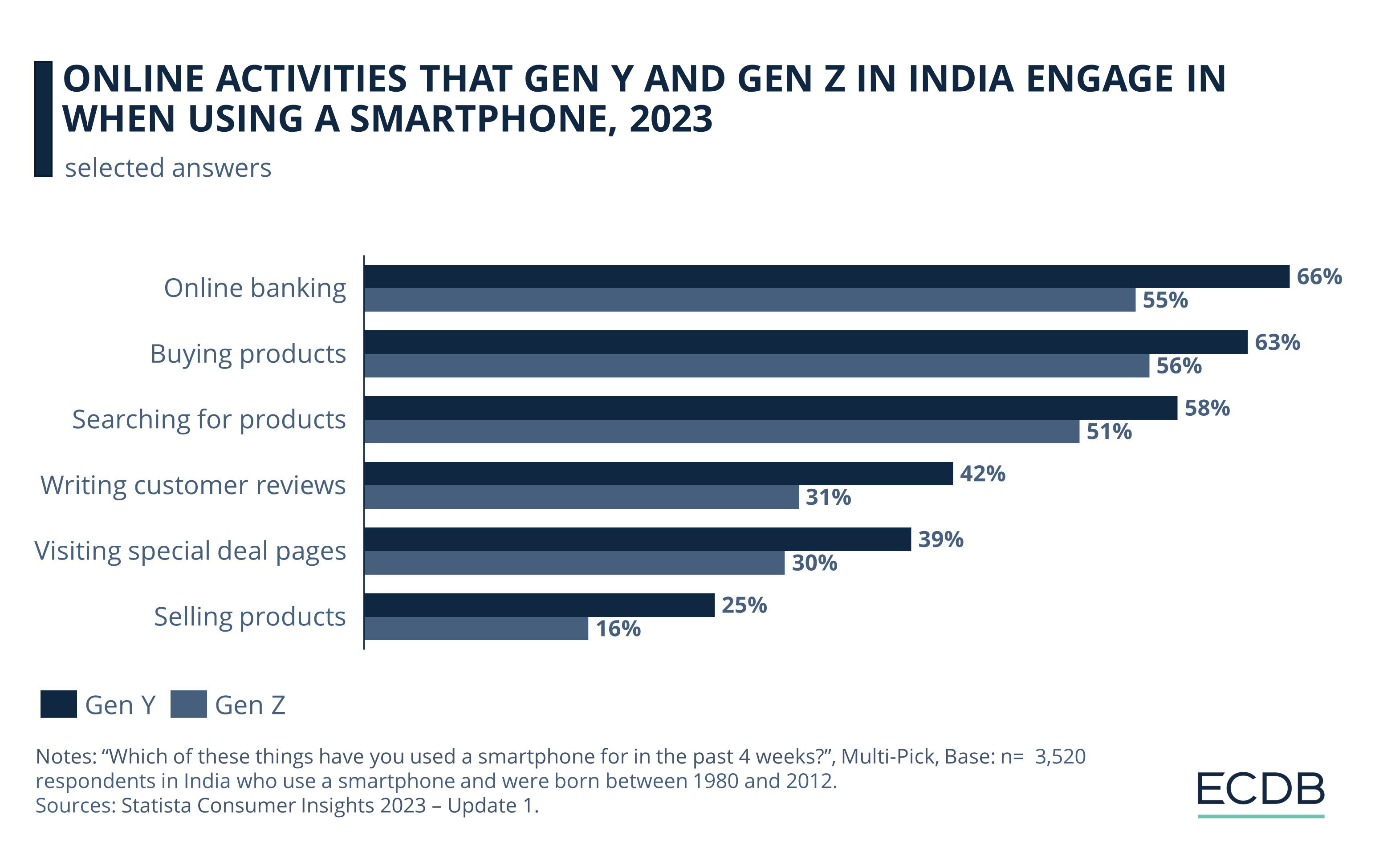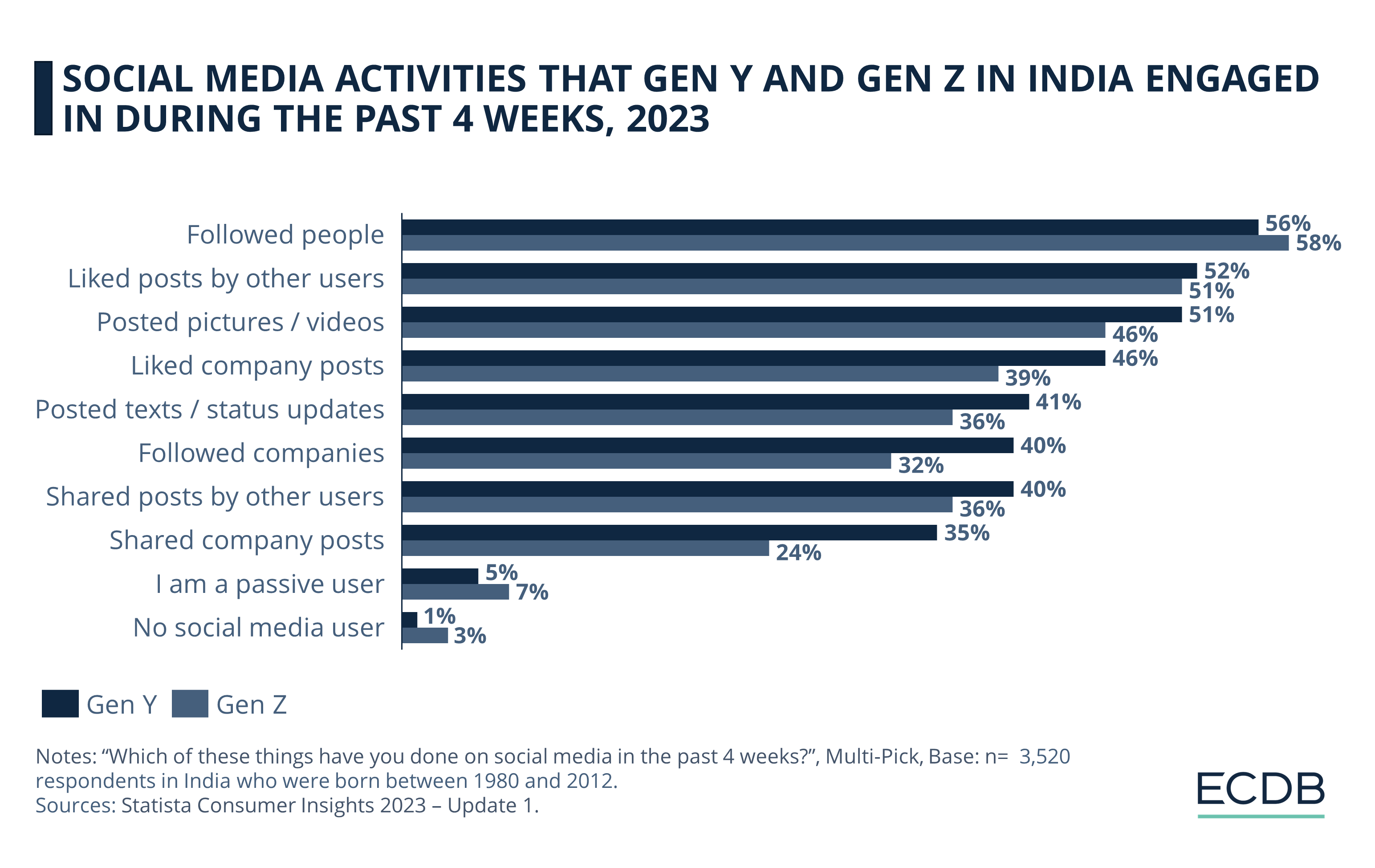eCommerce: Market & Consumer Insight
Gen Y and Gen Z in India: How Young Consumers Like to Shop Online
India is the most populous country in the world, and digital technologies are becoming increasingly common. Online shopping on mobile devices is a way of life in India. See how young consumers, Gen Y and Gen Z, are shaping Indian eCommerce.
Article by Nadine Koutsou-Wehling | April 12, 2024Download
Coming soon
Share

Gen Y and Gen Z in India: Key Insights
Online Shopping Behavior: Both Gen Y and Gen Z in India are familiar with eCommerce. But there tend to be differences in their online shopping behavior.
Importance of Technology and Privacy: Younger consumers in India are highly likely to consider the internet an integral part of their lives. But Gen Y respondents tend to be more concerned about data security and privacy.
Contextual Factors: Societal challenges such as high youth unemployment and unequal access to education persist. These factors impact internet access and online shopping priorities for all cohorts in India.
With a median age of 28¹ and about 65% of the population under the age of 35, India's 1.4 billion people include over 910 million millennials and Gen Z — the largest in the world. A young population not only means a large workforce, but is also more open to technology and innovation.
As India's median age falls while China's rises, India is well positioned for continued economic and online growth. Here is how India's Gen Y and Gen Z relate to the country's eCommerce.
Generations Y and Z in India
Millennials, or Gen Y (1980-1994) is also known as the first digitally native generation. They are followed by their younger siblings, Gen Z (1995-2012) who have learned the use of digital technology at an even younger age.
Similarities Between the Two Cohorts
There are several factors that are similar between members of both generations. Generations Y and Z in India are the first two cohorts to have benefited from India's transition to a more prosperous society at a young age. This development has been driven by the growth of India’s middle class, the entry of women into the workforce enabling both parents to work, and an overall increase in access to education.
But there are still structural barriers that lead to socioeconomic disparities in wealth, and education remains inadequate in many parts of the country, leading to high youth unemployment² and negative net migration (meaning more people leave the country than enter it).
Gen Y: Daily Internet Use More Common
Both Gen Y and Gen Z consider the internet to be an integral part of their daily lives. Statista’s 2023 Consumer Insights asked users in India about their attitudes towards the internet. Most respondents said that having mobile internet access at all times is important to them, with 62% of millennials and 52% of Gen Z consumers agreeing.
Gen Y consumers (48%) are also more likely than Gen Z (39%) to say they could no longer imagine everyday life without the internet.
The Indian government is responding to these online preferences by providing widespread internet connectivity to India’s population through programs such as Digital India.

A high-speed internet connection is important to 44% of millennial users, while Gen Z is less inclined to agree, at 29%. Concerns about privacy and data protection also vary, with Gen Y more concerned (33%) than the younger cohort (25%).
Gen Y: More Positive Views but Also Cautious
Gen Y and Gen Z have experienced similar developments during their formative years in India, such as the proliferation of the internet and growing societal prosperity. However, there are still differences in the prevailing generational mindsets that are observed among large sections of both groups:
While Gen Y respondents appear to have a more positive attitude toward the internet and tend to see it as an integral part of their everyday lives, they are also the ones who are more inclined to say they are apprehensive about its perils, such as data theft and loss of privacy.
Gen Y: Typical Online Shopping Behavior
Millennials tend to be highly interested in new technologies. Having been introduced to the internet at an early age, they sift through large amounts of information about a product online and are familiar with information or choice overload.

Gen Y and Gen Z consumers are more or less equally inclined to research a product online before making a major purchase, and buying from multiple sellers in an online marketplace.
Millennial respondents, however, exhibit a higher likelihood to make major new purchases via a mobile device (42%), something that Gen Z users do not do as often (34%).
About 40% of Gen Y consumers indicated a preference for express shipping. While they are much more likely than Gen Z to use a smartphone or tablet to manage their habitual orders, Gen Y and Gen Z consumers are about equally likely to prefer seeing and touching an item in person before buying it.
Gen Z: More Frugal and Less Engaged
Gen Zers share millennials’ ease in the digital world, but this does not mean they exhibit the same behavior as consumers.
A first pattern that emerges is that Gen Z consumers are said to be more cautious in their purchasing decisions and less likely to make impulse purchases.
Regarding the online activities that users in India engage in when using a smartphone, it appears that millennials have higher shares in each category, although the ranking of their common activities stays the same.

One factor that is important to note when interpreting these numbers: A 2018 report published by CBRE³ on youth housing across global regions shows that 82% of millennial Indians were living with their parents. This is attributed to the prevailing culture in the Asia-Pacific region, where it is common for people to live with their parents until they get married. Accordingly, it is to be expected that a large number of Gen Z Indian consumers will also be living with their parents, which significantly impacts the way they shop online.
While more than half of Gen Z respondents to the 2023 Statista Consumer Insights use their smartphones for online banking, buying products, and researching products, they are less interested in writing customer reviews, visiting special deal pages, or selling products.
Gen Z: More Passive Social Media Users
Regarding social media activity, millennial shares once again outpace Gen Z figures in every way, except that Gen Z respondents are slightly more likely to follow people on social media, 2 percentage points higher than the millennial figure of 56%.
However, there are more Gen Z respondents (7%) who said they are only passive users of social media, and do not post or comment anything, while 3% said that they haven’t used social media in the past 4 weeks.

Gen Z Respondents Less Likely to Interact With Brands Online
When it comes to interacting with brands, such as liking or sharing company posts, the gap between the two generations is the widest. Millennial respondents stated that they have liked a company post in the recent past at a 5 percentage points higher share than Gen Z, and this difference is even more pronounced when it comes to sharing posts, at 11 percentage points.
Overall, Gen Z users do not appear to be as enthusiastic about the faux-digital sociality of online platforms as is commonly portrayed. Particularly when it comes to business interactions, this cohort is less inclined to participate, reflecting the notion of a growing critique of materialistic values and status concerns.

Gen Y and Gen Z in India: Wrap-Up
India is an interesting market to follow, not least because of the vast opportunities for market expansion and finding new trends and innovations to sell. Not only does India have the largest number of Gen Y and Gen Z of any country in the world, but its population is digitally connected and eager to participate in global eCommerce.
The future looks bright for India, and market research backs it up. Knowing shopping habits and preferences early provides a competitive advantage: Gen Y's demand for convenience and speed, and Gen Z's greater concern for frugality and authenticity.
Sources: Bain & Company - Emerald Insight - Pew Research Center - Times of India - UN – World Population Prospects 2022
Related insights
Article
Gen Alpha: The New Consumer
Gen Alpha: The New Consumer
Article
Augmented Reality in eCommerce: Consumer Preferences and Use Cases of IKEA, Sephora, Walmart
Augmented Reality in eCommerce: Consumer Preferences and Use Cases of IKEA, Sephora, Walmart
Article
Live Commerce Trends in China: Market to Exceed US$1 Trillion by 2026
Live Commerce Trends in China: Market to Exceed US$1 Trillion by 2026
Article
Conversion Funnel: How to Increase Your Conversion Rate
Conversion Funnel: How to Increase Your Conversion Rate
Article
eCommerce in Saudi Arabia: Market Development and Top Categories
eCommerce in Saudi Arabia: Market Development and Top Categories
Back to main topics
